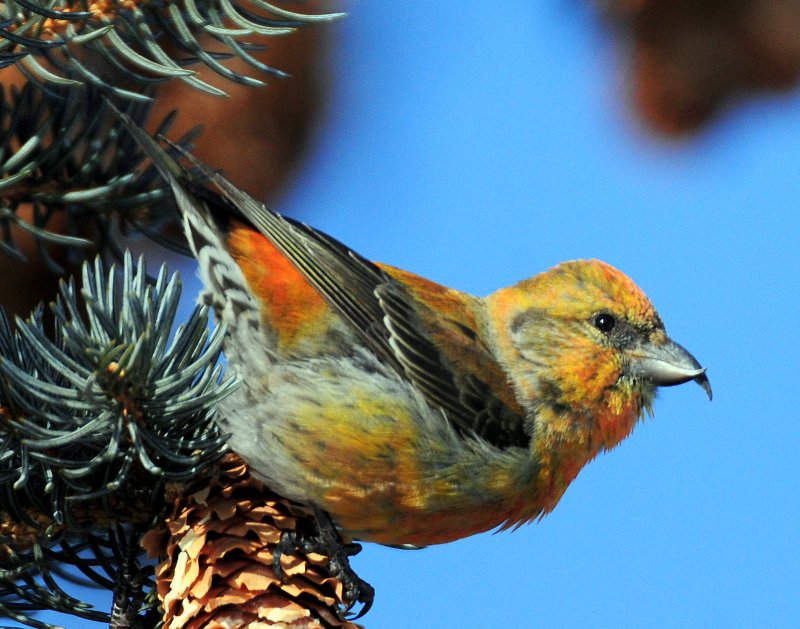Andrea Explains Fitting the Bill
Copyright © 2009 Paul Higgins
More photos at pbase.com/phiggins/
and utahbirds.org Photo Gallery
 Red Crossbill (female)
Red Crossbill (female)
Copyright © 2009 Paul Higgins
More photos at pbase.com/phiggins/Few among us would choose to eat a steak with a spoon or soup with a fork. And in the world of birds, it’s the same story – you need the right tool for the right job – and you can tell a lot about a bird by paying attention to its beak.Andrea Explains Fitting the Bill
Physiologically, beaks are a specialized extension of the skull and are coated in keratin – the same material that makes up our fingernails. And like our fingernails, the cutting edges of the beak can be re-grown as they are worn down by use.
Birds use beaks for a multitude of tasks including preening, weaving nests, and defending territories. However it is the task of eating that seems to dictate beak shape and size. Envision the hummingbird, for instance. Its long, thin beak – and corresponding tongue – is designed to reach deep into flowers to collect the nectar within. A hummingbird beak would not work for a woodpecker or a great horned owl. Likewise an eagle’s beak needs to be sharp and strong for tearing flesh, and wouldn’t suit the lifestyle of an ibis or a sparrow.
One Utah native, the aptly-named red crossbill, has one of the most unique beaks around. When closed, its curved top and bottom bills overlap crossways in what looks like an awkward and uncomfortable pose.
French naturalist Count Buffon, first laid eyes on a crossbill in the mid-1700’s. The bird was collected in the Americas, then shipped abroad for examination. Without observing the crossbill in its natural habitat, Buffon labeled its beak “an error and defect of nature, and a useless deformity.” More than 50 years later, Scottish-American naturalist Alexander Wilson observed a crossbill in the wild and determined that its beak ‘deformity’ was in reality a magnificently adapted tool. The crossbill’s diet consists mainly of the seeds of conifer trees, and it turns out that the bird’s curiously crossed beak is perfectly adapted to prying apart the scales of pinecones to get at the seeds within.
Members of the finch family, these birds are often seen in flocks and occasionally visit backyard feeders. They are easily identified by their unique beaks, which serve as a reminder that the right tool for the right job can sometimes seem a bit unconventional.
For more information and photographs of crossbills, visit our website at www.wildaboututah.org. Thank you to Rocky Mountain Power Foundation for supporting the research and development of this Wild About Utah topic.
For the Stokes Nature Center and Wild About Utah, this is Andrea Liberatore.
Credits:
Photos: Courtesy & Copyright Paul Higgins(phiggins)www.pbase.com/phiggins
Text: Andrea Liberatore, Stokes Nature Center, logannature.org
Additional Reading:
Benkman, Craig W. 1987. Crossbill Foraging Behavior, Bill Structure, and Patterns of Food Profitability. The Wilson Bulletin 99(3) p. 351-368 https://www.uwyo.edu/benkman/pdfs%20of%20papers/benkman_1987_wilsonbull.pdf
Conniff, Richard. 2011. The Species Seekers: Heroes, Fools and the Mad Pursuit of Life on Earth. W.W. Norton & Company: NY https://www.amazon.com/Species-Seekers-Heroes-Fools-Pursuit/dp/0393341321
Pearson, T. Gilbert (ed.). 1936. Birds of America. Garden City Publishing Company, Inc. Garden City, NY https://www.amazon.com/T-Gilbert-Pearson/dp/1331531268/ref=pd_lpo_14_t_0/144-1525643-4789824
Andrea Explains Fitting the Bill
Andrea Explains Fitting the Bill
